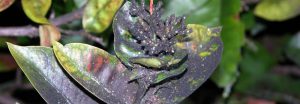A common question that UF IFAS Extension Services answers for residents of Flagler is, what is causing a black, soot like substance to accumulate on plant leaves. To get to the answer it may be helpful to look at the situation as a plant detective. If you closely inspect the blackened leaf and test it with your fingernail, you will find the substance can easily be rubbed off revealing a healthy leaf below. That is a clue that the black stuff isn’t actually harming the leaf. If you continue to examine the top of the tree or plant, you are likely to find some new leaves have a slightly sticky clear substance on them. If you keep looking you will probably notice tiny aphids, whiteflies, or some other insect feeding on the newly emerged leaves. All these things are related to the cause of the problem and taking the correct steps to alleviate the underlying issue.
To understand what is causing the black stuff, it may be helpful if you first understand that certain insects including soft scales, whiteflies, mealy bugs, and aphids excrete a sugary substance called honeydew. Excess sugar rich liquid oozes from the rear end of the insects as they use their piercing mouthparts to tap into the vascular tissues of plants to feed. Many other insects utilize this honeydew as food source including ants. Ants are known to protect aphids from predators and carry them to new un-infested plants to ensure future food supply. Feeding insect populations tend to be located higher up in tree canopies where the majority of new, tender leaves are found. For this reason the insects causing the issue may be more difficult to see, especially in a large tree. In areas with many host trees and heavy infestations, insect excretions can cause houses, driveways, and cars to become covered in sticky goo. Healthy plants underneath trees can also become covered. In those cases you are much more likely to become alarmed by honeydew, or the black material I am getting ready to explain.
 So what is the black soot like substance? It is actually called sooty mold. Sooty mold is a collective term for several types of fungi that cause similar black soot like appearance from dense dark threadlike fungal structures called mycelium that cover the leaf surface. Sooty mold spores land and germinate on honeydew excretions. Although unsightly, sooty mold by itself causes little damage. It may, under extreme conditions, reduce photosynthesis by blocking out sunlight that can reach the leaf surface. Sooty mold can accumulate in thick layers over the course of a growing season. This material will usually begin to flake off once the source of honeydew has been eliminated.
So what is the black soot like substance? It is actually called sooty mold. Sooty mold is a collective term for several types of fungi that cause similar black soot like appearance from dense dark threadlike fungal structures called mycelium that cover the leaf surface. Sooty mold spores land and germinate on honeydew excretions. Although unsightly, sooty mold by itself causes little damage. It may, under extreme conditions, reduce photosynthesis by blocking out sunlight that can reach the leaf surface. Sooty mold can accumulate in thick layers over the course of a growing season. This material will usually begin to flake off once the source of honeydew has been eliminated.
Treating the source of honeydew production is the key to controlling sooty mold. There are too many products to mention that can control aphids, whiteflies, mealybugs and soft scales. Selecting a treatment really depends on the situation. Taking into consideration if a plant is edible or ornamental can help to determine which over the counter product to use for a home landscape. Horticultural oils and insecticidal soaps can be excellent tools to combat plant feeding insects because they work by suffocating on contact: But, they have little or no residual toxicity which may kill beneficial insects that are present in your yard. Horticultural oils and insecticidal soaps require good coverage of the leaf surfaces and repeat applications to be effective. Horticultural oils can burn tender leaves when applied at temperatures above around 85 – 90 degrees Fahrenheit. Insecticidal soaps can also harm some tender plants, therefore read and follow product labels very closely. Some situations may justify utilizing stronger pesticides, but homeowners should consider environmental hazards and personal safety when making choices. For instance, applications of strong insecticides may have special considerations including avoiding treatment when plants are in bloom to protect foraging bees. Tolerating low levels of plant feeding insects is probably the most practical and environmentally responsible strategy.
The key to understanding sooty mold is recognizing the relationship between the fungus and the insects that excrete honeydew. If you see ants and black mold, you should probably take a closer look to see if there is another insect there feeding on the plant. A little detective work can help you solve the problem and focus your treatments on the source.
For more information visit “Guidelines to Identification and Management of Plant Disease Problems: Part I. Eliminating Insect Damage and Abiotic Disorders” http://edis.ifas.ufl.edu/mg441 , “Crapemyrtle Aphid, Tinocallis kahawaluokalani (Kirkaldy) (Insecta: Hemiptera: Aphididae)” http://edis.ifas.ufl.edu/in663 , and “Managing Whiteflies on Landscape Ornamentals” http://edis.ifas.ufl.edu/mg254
Sol Looker is the Residential Horticulture Extension Agent and Master Gardener Coordinator at the Flagler County Extension Service, University of Florida. For more information contact the office, (386) 437-7464. The Extension Service is located at 150 Sawgrass Road Bunnell, Florida 32110.
 0
0
